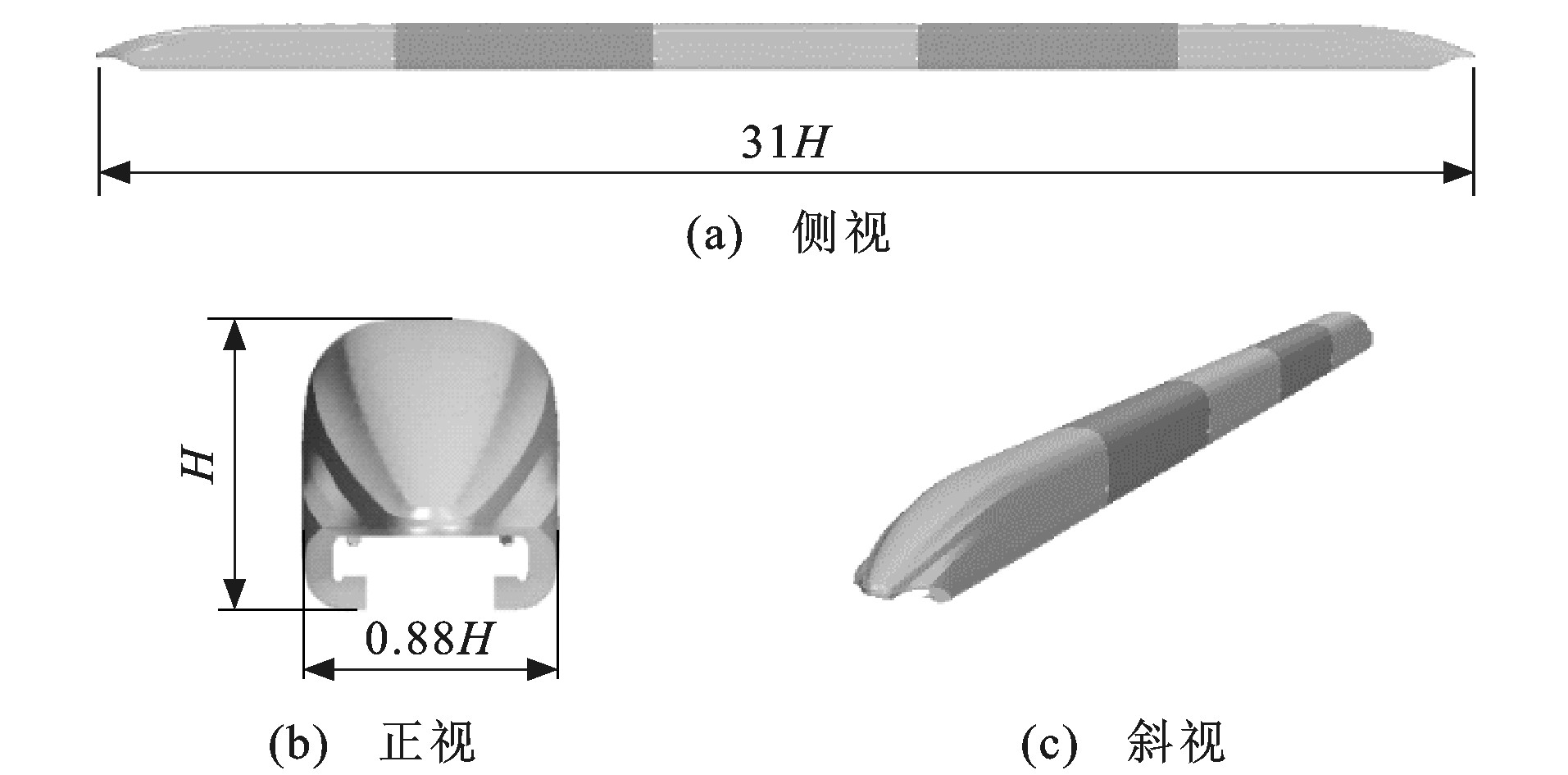Numerical simulation of initial compression wave characteristics of 600 km·h-1 maglev train entering tunnel
Article Text (Baidu Translation)
-
摘要: 为分析高速磁浮列车驶入隧道时产生的初始压缩波特征, 采用三维可压缩非定常流动的N-S方程和SST κ-ω湍流模型, 基于重叠网格法和有限体积法, 以国内正在研发的时速600 km高速磁浮列车头型为研究对象, 建立了高速磁浮列车驶入隧道的计算模型, 通过分析距隧道进口端内不同距离横截面上不同测点的压力及压力变化率, 得到了车头驶入隧道洞口初始压缩波的空间分布特性和传播特性, 以及不同速度对初始压缩波波动幅值的影响。研究结果表明: 初始压缩波在列车驶入隧道前开始形成, 形成初期具有三维特性, 在隧道截面同一高度上, 靠近车体一侧的初始压缩波压力要比远离车体一侧大; 在隧道截面同一侧, 靠近车体一侧高度越低, 初始压缩波压力越大, 而远离车体一侧初始压缩波压力与高度无关; 当列车驶入隧道一定距离后, 在列车头部前方约36 m处隧道内同一断面处压力相同, 初始压缩波由三维波变成一维平面波; 在列车流线型头部驶入隧道约0.15 m时, 位于隧道300 m测点处的初始压缩波的压力变化率达到最大值; 列车速度越高, 初始压缩波压力峰值越大, 位于隧道100 m处测点的初始压缩波的压力峰值与列车速度的2.5次方近似成正比, 压力变化率峰值与速度的3次方近似成正比。
-
关键词:
- 高速磁浮列车 /
- 隧道 /
- 重叠网格法 /
- 三维可压缩非定常湍流流动方程 /
- 初始压缩波
Abstract: In order to analyze the characteristics of initial compression wave generated when a high-speed maglev train enters a tunnel, the three-dimensional compressible unsteady flow N-S equation and the SST κ-ω turbulent flow model were used. Based on the overlapping grid method and the finite volume method, taking the head shape of a high-speed maglev train with a speed of 600 km·h-1, which was developing in China as a research object, a calculation model of a high-speed maglev train entering a tunnel was established. By analyzing the pressure and pressure change rate at different measuring points on different cross sections from entrance of tunnel, the spatial distribution characteristics and propagation characteristics of initial compression wave when the train heads enter into the tunnel opening were obtained, and the effect of different speeds on the amplitude of initial compression wave fluctuation were also obtained.Research result shows that the initial compression wave starts to form before the train enters the tunnel. It has three-dimensional characteristics at the initial stage of formation. At the same height of the tunnel cross section, the pressure of initial compression wave on the side closer to the train body is greater than the pressure on the side farther from the train body. On the same side of the tunnel cross section, the lower the height near the train body, the higher the pressure of initial compression wave, but the pressure of initial compression wave on the side far from the train body is independent of the height. When the train enters the tunnel for a certain distance at the position about 36 m in front of the train head, the pressure at the same section in the tunnel is the same, and the initial compression wave changes from a three-dimensional wave to a one-dimensional plane wave. When the streamlined head of train enters the tunnel at about 0.15 m, the pressure change rate of initial compression wave at the 300 m measuring point at the tunnel reaches the maximum value. The higher the train speed, the greater the peak pressure of the initial compression wave. The peak pressure of initial compression wave at the 100 m measuring point at the tunnel is approximately proportional to the 2.5 th power of the train speed, and the peak pressure change rate is approximately proportional to the 3 rd power of the speed. -
表 1 试验值与计算值对比
Table 1. Comparison between experimental and calculated values
参数 a b c d 试验值/kPa 4.46 -4.03 -4.14 2.36 计算值/kPa 4.70 -4.06 -4.01 2.22 误差/% 5.4 0.7 3.1 5.9 -
[1] BARO A, MOLTENI P, VIGEVANO L. High-speed trains: prediction of micro-pressure wave radiation from tunnel portals[J]. Journal of Sound and Vibration, 2006, 296: 59-72. doi: 10.1016/j.jsv.2006.01.067 [2] 姚拴宝, 陈大伟, 林鹏, 等. 单线高速铁路隧道入口缓冲结构几何外形优化设计[J]. 中国铁道科学, 2018, 39(5): 80-87. doi: 10.3969/j.issn.1001-4632.2018.05.11YAO Shuan-bao, CHEN Da-wei, LIN Peng, et al. Geometric shape optimization design for buffer structure at tunnel entrance of single track high speed railway[J]. China Railway Science, 2018, 39(5): 80-87. (in Chinese). doi: 10.3969/j.issn.1001-4632.2018.05.11 [3] AOKI T, VARDY A E, BROWN J M B. Passive alleviation of micro-pressure waves from tunnel portals[J]. Journal of Sound and Vibration, 1999, 220(5): 921-940. doi: 10.1006/jsvi.1998.2006 [4] RAGHUNATHAN R S, KIM H D, SETOGUCHI T. Aerodynamics of high-speed railway train[J]. Progress in Aerospace Sciences, 2002, 38: 469-514. doi: 10.1016/S0376-0421(02)00029-5 [5] 梅元贵, 王瑞丽, 许建林, 等. 高速列车进入隧道诱发初始压缩波效应的数值模拟[J]. 计算力学学报, 2016, 33(1): 95-102. https://www.cnki.com.cn/Article/CJFDTOTAL-JSJG201601015.htmMEI Yuan-gui, WANG Rui-li, XU Jian-lin, et al. Numerical simulation of initial compression wave induced by a high-speed train moving into a tunnel[J]. Chinese Journal of Computational Mechanics, 2016, 33(1): 95-102. (in Chinese). https://www.cnki.com.cn/Article/CJFDTOTAL-JSJG201601015.htm [6] 刘堂红, 田红旗, 梁习锋. 缓冲结构对隧道口微气压波的影响[J]. 中南大学学报(自然科学版), 2009, 40(5): 1306-1311. https://www.cnki.com.cn/Article/CJFDTOTAL-ZNGD200905025.htmLIU Tang-hong, TIAN Hong-qi, LIANG Xi-feng. Influence of hood on micro-pressure wave[J]. Journal of Central South University (Science and Technology), 2009, 40(5): 1306-1311. (in Chinese). https://www.cnki.com.cn/Article/CJFDTOTAL-ZNGD200905025.htm [7] OGAWA T, FUJII K. Numerical investigation of three-dimensional compressible flows induced by a train moving into a tunnel[J]. Computers and Fluids, 1997, 26(6): 565-585. doi: 10.1016/S0045-7930(97)00008-X [8] ZHANG Lei, THUROW K, STOLL N, et al. Influence of the geometry of equal-transect oblique tunnel portal on compression wave and micro-pressure wave generated by high-speed trains entering tunnels[J]. Journal of Wind Engineering and Industrial Aerodynamics, 2018, 178: 1-17. doi: 10.1016/j.jweia.2018.05.003 [9] MATSUO K, AOKI T, MASHIMO S, et al. Entry compression wave generated by a high-speed train entering a tunnel[J]. Transactions of the JSME, 1995, 61: 925-934. [10] MIYACHI T. Acoustic model of micro-pressure wave emission from a high-speed train tunnel[J]. Journal of Sound and Vibration, 2017, 391: 127-152. doi: 10.1016/j.jsv.2016.09.031 [11] KLOPFER G H, MEHTA U B. Aerodynamic computations for a high-speed, magnetic-flight system[C]//AIAA. 33rd Aerospace Sciences Meeting and Exhibit. Reston: AIAA, 1995: 1-18. [12] 宋军浩, 郭迪龙, 杨国伟, 等. 高速列车隧道通过中的气动效应动模型实验研究[J]. 实验流体力学, 2017, 31(5): 39-45. https://www.cnki.com.cn/Article/CJFDTOTAL-LTLC201705004.htmSONG Jun-hao, GUO Di-long, YANG Guo-wei, et al. Experimental investigation on the aerodynamics of tunnel-passing for high speed train with a moving model rig[J]. Journal of Experiments in Fluid Mechanics, 2017, 31(5): 39-45. (in Chinese). https://www.cnki.com.cn/Article/CJFDTOTAL-LTLC201705004.htm [13] 吴剑, 史宪明, 万晓燕. 时速300-350 km高速铁路双线隧道微气压波激化作用及缓解措施研究[J]. 土木工程学报, 2017, 50(增2): 209-214. https://www.cnki.com.cn/Article/CJFDTOTAL-TMGC2017S2033.htmWU Jian, SHI Xian-ming, WAN Xiao-yan. Study on intensification and mitigation methods of micro pressure wave of double track in 300 to 350 km·h-1 high speed railway[J]. China Civil Engineering Journal, 2017, 50(S2): 209-214. (in Chinese). https://www.cnki.com.cn/Article/CJFDTOTAL-TMGC2017S2033.htm [14] 张兆杰, 高波, 王英学. 磁悬浮列车穿越隧道引起的压力波传播规律研究[J]. 石家庄铁道学院学报, 2005, 18(4): 11-14. https://www.cnki.com.cn/Article/CJFDTOTAL-SJZT200504002.htmZHANG Zhao-jie, GAO Bo, WANG Ying-xue, et al. Study of propagation pattern of pressure waves produced by magnetically levitated train in passing a tunnel[J]. Jounal of Shijiazhuang Railway Institute, 2005, 18(4): 11-14. (in Chinese). https://www.cnki.com.cn/Article/CJFDTOTAL-SJZT200504002.htm [15] 黄兆国. 超高速磁浮列车空气动力学问题研究[D]. 成都: 西南交通大学, 2018.HUANG Zhao-guo. Study on aerodynamics of super high speed maglev train[D]. Chengdu: Southwest Jiaotong University, 2018. (in Chinese). [16] 姚曙光, 许平. 国产磁浮列车外形气动性能分析[J]. 铁道机车车辆, 2007, 27(3): 33-34, 69. https://www.cnki.com.cn/Article/CJFDTOTAL-TDJC200703011.htmYAO Shu-guang, XU Ping. Aerodynamic shape optimization of domestic maglev train[J]. Railway Locomotive and Car, 2007, 27(3): 33-34, 69. (in Chinese). https://www.cnki.com.cn/Article/CJFDTOTAL-TDJC200703011.htm [17] 刘堂红, 田红旗. 磁浮列车明线交会横向振动分析[J]. 交通运输工程学报, 2005, 5(1): 39-44. http://transport.chd.edu.cn/article/id/200501010LIU Tang-hong, TIAN Hong-qi. Transverse vibration analysis of two maglev trains passing by in open air[J]. Journal of Traffic and Transportation Engineering, 2005, 5(1): 39-44. (in Chinese). http://transport.chd.edu.cn/article/id/200501010 [18] 史宪明, 吴剑, 冷希乔, 等. 补强套衬对高速铁路隧道洞口微气压波的影响[J]. 铁道建筑, 2017, 57(10): 53-55, 59. https://www.cnki.com.cn/Article/CJFDTOTAL-TDJZ201710014.htmSHI Xian-ming, WU Jian, LENG Xi-qiao, et al. Influence of added lining on micro pressure wave of high speed railway tunnel portals[J]. Railway Engineering, 2017, 57(10): 53-55, 59. (in Chinese). https://www.cnki.com.cn/Article/CJFDTOTAL-TDJZ201710014.htm [19] 毕海权, 雷波, 张卫华. TR型磁浮列车气动力特性数值计算研究[J]. 铁道学报, 2004, 26(4): 51-54. https://www.cnki.com.cn/Article/CJFDTOTAL-TDXB200404011.htmBI Hai-quan, LEI Bo, ZHANG Wei-hua. Research on numerical calculation for aerodynamic characteristics of the TR maglev train[J]. Journal of the China Railway Society, 2004, 26(4): 51-54. (in Chinese). https://www.cnki.com.cn/Article/CJFDTOTAL-TDXB200404011.htm [20] TEBBUTT J A, VAHDATI M, CAROLAN D, et al. Numerical investigation on an array of Helmholtz resonators for the reduction of micro-pressure waves in modern and future high-speed rail tunnel systems[J]. Journal of Sound and Vibration, 2017, 400: 606-625. [21] XIANG Xin-tao, XUE Lei-ping, WANG Ben-long, et al. Mechanism and capability of ventilation openings for alleviating micro-pressure waves emitted from high-speed railway tunnels[J]. Building and Environment, 2018, 132: 245-254. [22] 李守华. 磁悬浮列车若干空气动力学问题的数值研究[D]. 兰州: 兰州大学, 2006.LI Shou-hua. Numerical research of several aerodynamical problems on maglev vehicle[D]. Lanzhou: Lanzhou University, 2006. (in Chinese). [23] 李人宪, 翟婉明. 磁悬浮列车横风稳定性的数值分析[J]. 交通运输工程学报, 2001, 1(1): 99-101. http://transport.chd.edu.cn/article/id/200101025LI Ren-xian, ZHAI Wan-ming. Numerical analysis of crosswind stability of magnetically levitated trains[J]. Journal of Traffic and Transportation Engineering, 2001, 1(1): 99-101. (in Chinese). http://transport.chd.edu.cn/article/id/200101025 [24] 舒信伟, 谷传纲, 梁习锋, 等. 高速磁浮列车气动阻力性能数值模拟与参数化评估[J]. 交通运输工程学报, 2006, 6(2): 6-10. http://transport.chd.edu.cn/article/id/200602002SHU Xin-wei, GU Chuan-gang, LIANG Xi-feng, et al. Numerical simulation and parameterized investigation of aerodynamic drag performances of high-speed maglev trains[J]. Journal of Traffic and Transportation Engineering, 2006, 6(2): 6-10. (in Chinese). http://transport.chd.edu.cn/article/id/200602002 [25] 马东宝. 时速600公里磁浮列车隧道压力波及气动力特性研究[D]. 兰州: 兰州交通大学, 2018.MA Dong-bao. Study on pressure wave and aerodynamic characteristics of a maglev train passing through the tunnel at 600 km·h-1[D]. Lanzhou: Lanzhou Jiaotong University, 2018. (in Chinese). [26] MENTER F R. Trends and challenges in modelling complex turbulent flows[C]//Springer. The 14th International Conference on Fluid Flow Technologies. Berlin: Springer, 2009: 1-10. [27] MENTER F R. Performance of popular turbulence models for attached and separated adverse pressure gradient flows[J]. AIAA Journal, 1992, 30(8): 2066-2072. [28] SAITO S, IIDA M, KAJIYAMA H. Numerical simulation of 1-D unsteady compressible flow in railway tunnels[J]. Journal of Environment and Engineering, 2011, 6(4): 723-738. -





 下载:
下载:





















